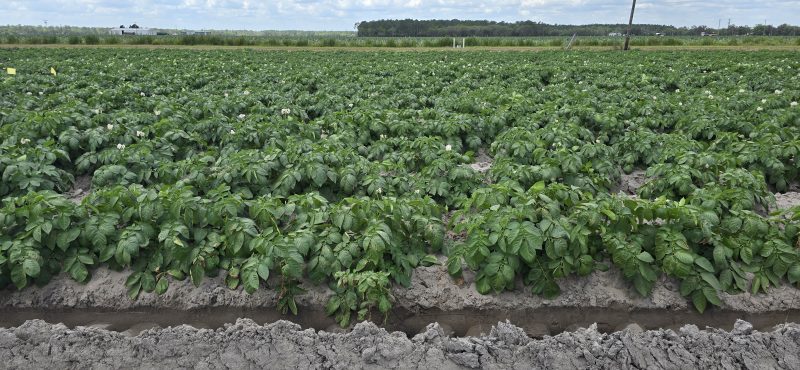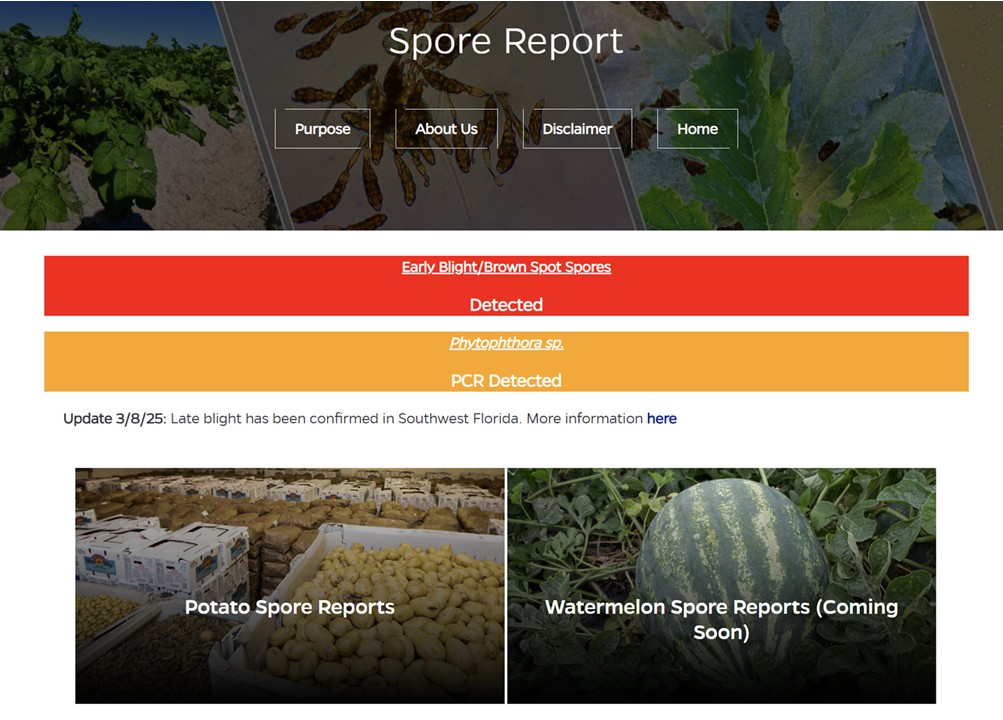
The University of Florida is providing potato farmers an early warning service on the potato pathogens Early Blight, Brown Spot and Late Blight in North Florida. Starting in May, they will also begin monitoring for powdery mildew in watermelons. Credit: Nick Dufault, UF/IFAS
Dr. Nicholas Dufault and Rezel Borines, UF/IFAS Plant Pathology Department
With potato and watermelon seasons underway in North Florida, growers are keeping a close eye on disease risk. One way to get ahead of potential problems is with the Spore Report—a new web-based tool developed by UF/IFAS researchers to help monitor plant disease threats before they’re visible in the field.
–
What is the Spore Report?
The Spore Report is a web-based platform that tracks the aerial presence of fungal pathogen spores in a region, giving growers and consultants a heads-up on the pathogen’s presence before disease symptoms appear. It currently focuses on the potato pathogens Early Blight, Brown Spot and Late Blight.
This tool is based on data collected using active and passive spore traps, deployed on a regional scale rather than a field-by-field basis. The goal is to give a broader insight into disease pressure in North Florida’s key production areas.
–
Over time, this resource will grow to provide more than just detection. Plans are in place to track fungicide resistance traits, population shifts in pathogens, and to include environmental models for various diseases.
–
Coming Soon: Watermelon Powdery Mildew Monitoring
Starting next month, the Spore Report will introduce a dedicated resource focusing on powdery mildew in watermelons. Powdery mildew, caused by fungi such as Podosphaera xanthii, is a major concern for watermelon and cucurbit growers. It shows up as white, powdery spots on leaves and stems, reducing photosynthesis, causing early leaf drop and lowering fruit quality.
–
What’s Next for the Spore Report
Even if spores are detected, disease doesn’t always develop. That’s why researchers are integrating environmental decision support models for the diseases—to help growers better assess when action is truly needed.
In 2025, the tool will also begin reporting genotypic data, starting with traits for FRAC Group 11 fungicide resistance (QoI resistance), and expanding from there. This will allow for more informed product selection and resistance management planning.
A historical archive is also in development, giving users the ability to compare spore trap results and disease trends over multiple seasons.
–
Why This Matters
Whether you’re farming 5 acres or 500, catching disease early can protect yield and save money. The Spore Report helps answer critical questions like:
“Is the disease in my area yet?”
“Is it time to apply a fungicide?”
“Which products are likely to be effective?”
While the tool is still in development, it’s already providing real-world value to growers and agricultural consultants. As features continue to roll out, this tool will become an even more powerful part of your integrated pest management program.
–
Where to Find it:
The Spore Report is housed on the UF/IFAS Department of Plant Pathology Website. Use the following link to access the website:
Spore Report
–
For help using the tool or questions about the upcoming features, reach out to Dr. Nicholas Dufault.
- 2025 End-of-Season Florida Peanut Disease Notes - October 24, 2025
- Southern Rust Confirmed in the Florida Panhandle – June 2025 - June 6, 2025
- Stay Ahead of Disease with the Spore Report: A New Tool to Assist with Potato and Watermelon Management - April 11, 2025


